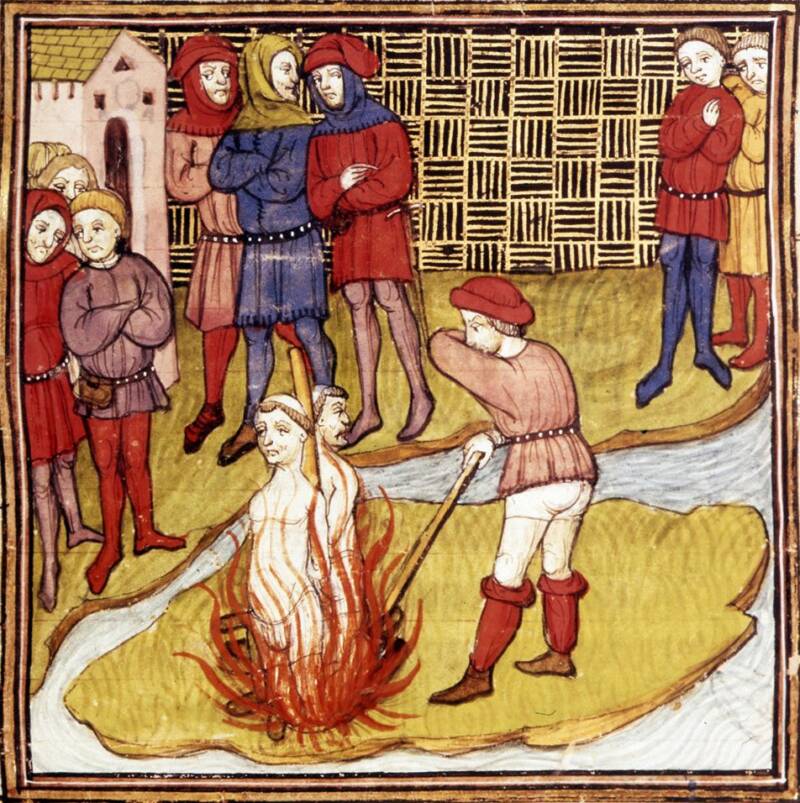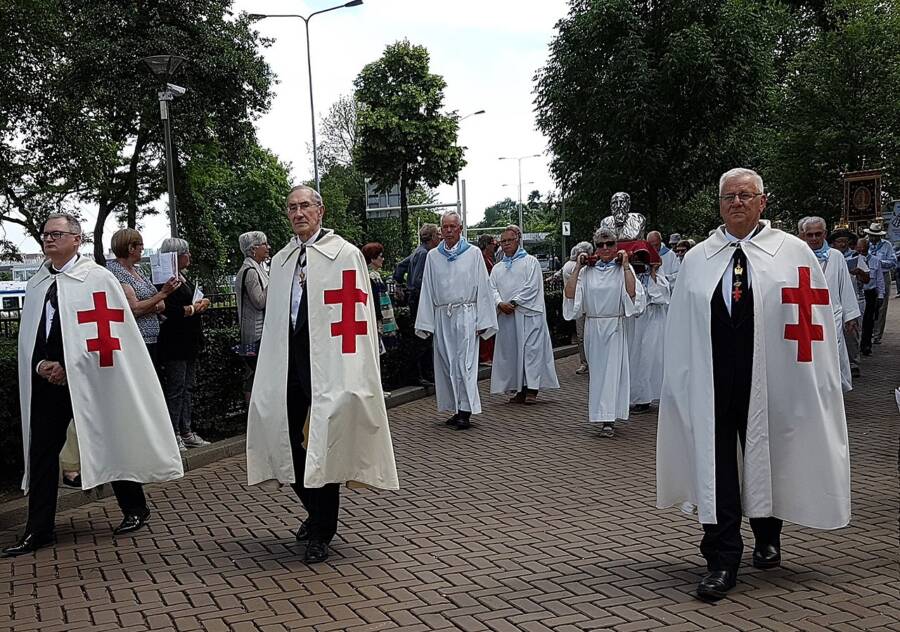The Knights Templar was a Catholic military order formed during the Crusades — and some believe the group found the legendary Holy Grail while in Jerusalem.

Walker Art Library / Alamy Stock PhotoThe Knights Templar existed for hundreds of years before its terrible fall — though some believe the group never went away.
When the influential French abbot Bernard of Clairvaux sat down to write about the Knights Templar around 1136, he described the members of the order as “fearless knight[s]” protected by the armor of “faith” and “steel.” They were, he wrote, “thus doubly-armed, and need fear neither demons nor men.”
Indeed, the small group of “warrior monks” — which was originally formed to protect European Christians traveling to the Holy Land after the First Crusade — soon grew so large and powerful that its members feared no one. Governed by a strict set of rules, the knights defended pilgrims, set up a sprawling network of banks, and answered to nobody but the pope.
But their power did not last. As European forces lost their hold on the Holy Lands, the Knights Templar’s invincible reputation suffered. The group became a target of resentful monarchs, and the order was disbanded in the 14th century as its members were tortured, imprisoned, and burned at the stake.
Still, not everyone believes that the Knights Templar ceased to exist.
An Order Formed To Protect Pilgrims
During the First Crusade (1096 to 1099), European armies marched on the Middle East to take back territory in the “Holy Lands” that had been seized by Muslim forces. Though they were successful, the Holy Lands remained a dangerous place to be — especially for the Christian pilgrims who poured east.

Public DomainMedieval Jerusalem. After the First Crusades, Christian pilgrims poured into the Holy Land but were often targeted by robbers and bandits.
A French knight named Hugues de Payens, who had spent time in Jerusalem, recognized that these pilgrims needed to be defended. He created a military order around 1119 with eight or nine of his relatives and acquaintances which they called “the Poor Fellow-Soldiers of Christ and the Temple of Solomon.” Their base was located on the Temple Mount, and before long, they were known simply as the Knights Templar.
At first, the Knights Templar did exactly what de Payens had intended. Sanctioned by King Baldwin II of Jerusalem, the group escorted and protected pilgrims. In return, the king allocated tax revenue to the order to keep the knights clothed and fed (though the original members were already wealthy).
From there, the Knights Templar began to transform from a ragtag group into an official organization. Governed by strict rules and approved by the Catholic Church, its reach began to extend far beyond the Holy Land.
The Sanctification Of The Knights Templar
In 1129, the Council of Troyes created an extensive list of rules that men in the Knights Templar had to follow. They ranged from the basic (how the men should wear their beards, what kind of horses they should ride, etc.) to the more extreme. Knights in the order could not spend any time with women — including female members of their family — nor retreat during a battle.
They were expected to pray often, remain chaste, and swear an oath to poverty and obedience.
Failing to follow these rules could result in dire consequences. Members were subject to corporal punishment, forced to eat their meals off the floor, or even banished from the order entirely. (However, many of these rules became more lax as the Knights Templar recruited more members.)
The growth of the Knights Templar was not without controversy, however. Religious men weren’t supposed to wield swords, and many protested against the knights’ use of violence. But the Catholic Church gave the order its glowing approval. Not only did prominent Christian figures like Bernard of Clairvaux profess their support of the Knights Templar, but Pope Innocent II issued a papal bull in 1139 that sanctified the group.

The Print Collector / Alamy Stock PhotoMembers of the Knights Templar were fierce fighters, though some believed that religious men shouldn’t carry swords.
His ruling stated that members did not have to pay taxes or tithes, that they could travel across borders, and that they answered only to the pope.
Over the next two centuries, the Knights Templar — led by a Grand Master originally stationed in Acre, Israel — grew to do much more than protect pilgrims. Its members fought in the Crusades, established chapters across Europe, set up a banking system that allowed pilgrims to manage their funds, and even came to control Cyprus. The order did business with kings, built castles and churches, and controlled its own fleet of ships.
But its power would not last. As the tide of the Crusades turned against European forces, so did popular opinion against the Knights Templar.
Arrests, Torture, And Executions: Inside The Fall Of The Knights Templar
In 1291, the Crusades came to an end. Muslim forces retook the Holy Lands, and the Knights Templar was one of the groups that shouldered the blame.
Increasingly criticized for its wealth and power, the order faced a reckoning back in Europe. Philip IV of France — who was in debt to the group and perhaps bore a grudge for its refusal to issue more loans — ordered the arrests of French Templars on Oct. 13, 1307. (This arrest occurred on a Friday, which has led some to link the Knights Templar to superstitions about Friday the 13th. However, there is no known connection.)
The arrested knights faced salacious charges of worshipping idols, spitting on the cross, and kissing each other during induction ceremonies. Dan Jones, author of The Templars: The Rise and Spectacular Fall of God’s Holy Warriors told Live Science in 2021 that this ceremony did include a “Kiss of Peace,” but it wasn’t considered problematic until the knights’ arrest.

Public DomainMany knights, including the Grand Master, were found guilty and burned at the stake.
Under torture, which included starvation, sleep deprivation, relentless questioning, “fire torture,” and the “strappado,” in which a victim was yanked up by his arms until his shoulders dislocated, many knights confessed to the charges. Even the Grand Master, Jacques de Molay, confessed to renouncing Christ and spitting near (but not on) the cross.
Though Pope Clement V absolved the knights of heresy in 1308, he disbanded the Knights Templar under pressure from Philip IV in 1312. Dozens, including de Molay, were subsequently burned at the stake.
With that, the Knights Templar ceased to exist. Or did it?
How The Organization Continues To Exist Today
Though the Knights Templar was disbanded more than 700 years ago, the order has continued to fascinate. As Jones wrote for GQ in 2018, early versions of the King Arthur legend included knights called the Templeisen who guarded the Holy Grail. The Knights Templar has also been linked to other elusive sacred objects, including the Shroud of Turin and the Ark of the Covenant.
Likewise, Dan Brown suggested in his novel The Da Vinci Code that the Knights Templar was determined to preserve the bloodline of Jesus Christ.
These are just stories. But the Knights Templar — or at least versions of the original organization — has, in fact, continued to exist into modern times.
As Smithsonian Magazine reports, the Knights Templar remains popular with European neo-fascists. Knights Templar International connects far-right activists online, particularly in the United Kingdom, and the Norwegian mass murderer Anders Breivik claimed to be part of the group.

Kleon3/Wikimedia CommonsMembers of the Sovereign Military Order of the Temple of Jerusalem in 2018.
That said, other versions of the organization are more innocuous. Freemasons purportedly adopted some of the order’s traditions in the 18th century, and Napoleon Bonaparte recognized a new rendition of the Knights Templar called Ordo Supremus Militaris Templi Hierosolymitani in the 19th century. In the 1960s, an organization known as the Sovereign Military Order of the Temple of Jerusalem (SMOTJ) was formed under the umbrella of the latter.
Smithsonian Magazine reports that they’re mostly concerned with Knights Templar history, though they also embrace the organization’s values like evangelical Christian advocacy, financial expertise, and service. One member told the magazine: “The only thing we don’t do is fight.”
In that way, the spirit of the Knights Templar is very much alive. Seven centuries after the last Grand Master was burned at the stake, groups continue to gather across the world to honor the order’s ancient traditions.
After reading about the rise and fall of the Knights Templar, look through these fascinating facts about life in the Middle Ages. Or, discover the complicated answer to the question: “Who wrote the Bible?”





